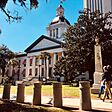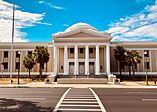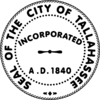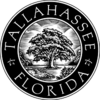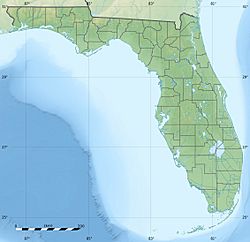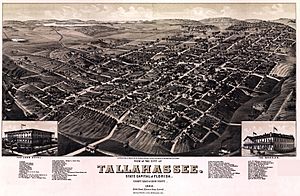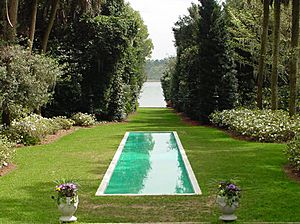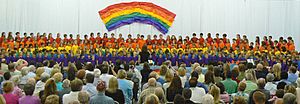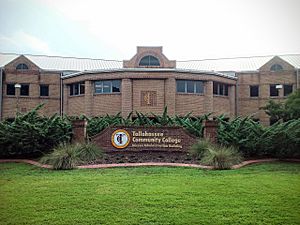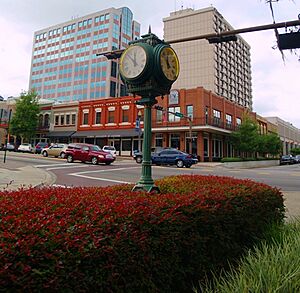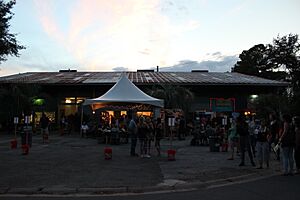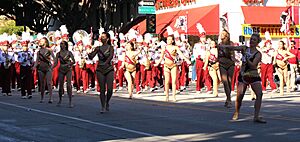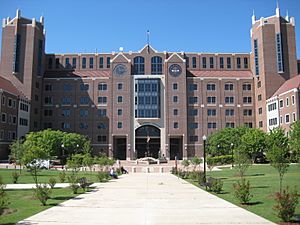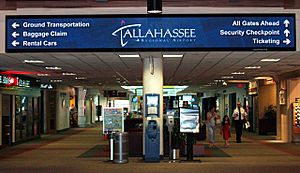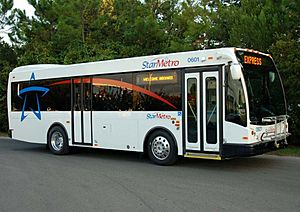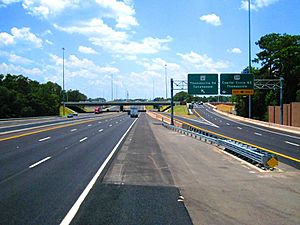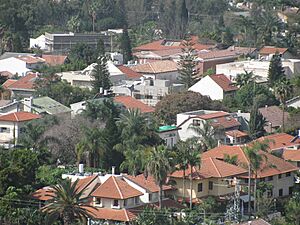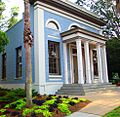Tallahassee, Florida facts for kids
Quick facts for kids
Tallahassee
|
|||||
|---|---|---|---|---|---|
|
Downtown Tallahassee
Florida Capitol
Florida Supreme Court
Tallahassee State College
|
|||||
|
|||||
| Motto(s):
"Florida's Capital City"
|
|||||
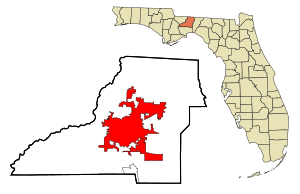
Location within Leon County and the state of Florida
|
|||||
| Country | |||||
| State | |||||
| County | Leon | ||||
| Established | 1824 | ||||
| Incorporated | 1825 | ||||
| Government | |||||
| • Type | Commission–Manager | ||||
| Area | |||||
| • Total | 104.74 sq mi (271.27 km2) | ||||
| • Land | 101.85 sq mi (263.80 km2) | ||||
| • Water | 2.89 sq mi (7.47 km2) | ||||
| Elevation | 203 ft (62 m) | ||||
| Population
(2020)
|
|||||
| • Total | 196,169 | ||||
| • Estimate
(2022)
|
201,731 | ||||
| • Rank | 123rd, U.S. | ||||
| • Density | 1,926.00/sq mi (743.64/km2) | ||||
| • Urban | 252,934 (US: 162nd) | ||||
| • Urban density | 2,016.1/sq mi (778.4/km2) | ||||
| • Metro | 390,992 (US: 140th) | ||||
| Time zone | UTC−5 (Eastern (EST)) | ||||
| • Summer (DST) | UTC−4 (EDT) | ||||
| ZIP Codes |
32301–32318, 32399
|
||||
| Area code(s) | 850/448 | ||||
| FIPS code | 12-70600 | ||||
| GNIS feature ID | 308416 | ||||
Tallahassee (pronounced TAL-ə-HASS-ee) is the capital city of Florida, a state in the United States. It is the only main city in Leon County. Tallahassee became Florida's capital in 1824.
In 2022, about 201,731 people lived there. This makes it the eighth-largest city in Florida. Tallahassee is also the biggest city in the Florida Big Bend and Florida Panhandle areas.
Tallahassee is a big college town. Over 70,000 students attend its universities. These include Florida State University, Florida A&M University, and Tallahassee State College.
As the capital, Tallahassee is home to important government buildings. You can find the Florida State Capitol, the Supreme Court of Florida, and the Florida Governor's Mansion here. Many state offices are also in the city. Tallahassee is also known for its many law firms and business groups. It is a center for science research, too. The city won the All-America City Award in 2015 for its community efforts.
Contents
History of Tallahassee

People have lived in this area for thousands of years. Around 1200, a group called the Mississippian culture built large earth mounds. These mounds can still be seen today at Lake Jackson Archaeological State Park.
The Spanish Empire started its first settlement in Florida at St. Augustine. In the 1600s, they built missions in the Apalachee territory. These missions helped them get food and workers. They also aimed to teach the native people about Roman Catholicism. The biggest mission, Mission San Luis de Apalachee, has been partly rebuilt in Tallahassee.
The explorer Hernando de Soto and his group stayed in the Apalachee town of Anhaica. This was in the winter of 1538–39. Anhaica was located near where the Florida State Capitol is today. People believe this was the first place Christmas was celebrated in the United States.
The name Tallahassee comes from a Muskogean language. It means "old fields" or "old town." This name likely came from the Creek people. They moved to this area from Georgia and Alabama in the late 1700s and early 1800s. They found large areas of land that the Apalachee tribe had cleared.
During the First Seminole War, General Andrew Jackson fought battles near Tallahassee. The first battle happened on November 12, 1817. Jackson burned the village of Fowltown after its chief refused to move. The native people fought back, and Jackson returned in 1818.
Becoming Florida's Capital
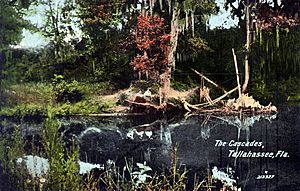
Florida became a U.S. territory in September 1821. The first government meetings were held in Pensacola. Traveling between Pensacola and St. Augustine (the other main city) was very hard. It took many days by water.
So, leaders decided to find a place halfway between them. They chose Tallahassee in 1824. At that time, it was mostly an abandoned Apalachee settlement. The third government meeting took place there in a simple log building.
From 1821 to 1845, Tallahassee slowly grew into a town. The Marquis de Lafayette, a French hero, visited the U.S. in 1824. The U.S. Congress gave him land, including parts of modern Tallahassee. In 1845, a new Capitol building was finished. This building, now called the "old Capitol," still stands today.
Tallahassee was important for cotton farming in Florida. It was also a center for the slave trade. During the American Civil War, Tallahassee was special. It was the only Confederate capital east of the Mississippi River that Union forces did not capture or burn. A small battle, the Battle of Natural Bridge, happened south of the city in March 1865. This was just before the war ended.

In the 1800s, schools that would become Florida State University started in Tallahassee. These included the Tallahassee Female Academy (1843) and the Florida Institute (1854). In 1887, the Normal College for Colored Students opened. This school later became FAMU. It was created to train African-American teachers.
After the Civil War, many of Florida's businesses moved south and east. This trend continues today. Cotton farming became less profitable. New industries like citrus, lumber, and tourism grew. Many wealthy people from the North bought old farms in Tallahassee. They used them as places for winter hunting. One such place, the Tall Timbers Research Station, now studies how fire affects nature.
Tallahassee in the 1900s and 2000s
Until World War II, Tallahassee was a small Southern town. Its main jobs came from the colleges and the state government.
Tallahassee was also important during the civil rights era. The Tallahassee bus boycott happened in 1956. People stopped riding city buses to protest unfair rules about seating and jobs. The boycott ended when the U.S. Supreme Court ruled against bus segregation. In 1972, James R. Ford became the city's first African-American mayor.
In 1976, Bobby Bowden became the coach for Florida State Seminoles football. He made college football very popular in Tallahassee. His team became very successful.
In 1977, a new 22-story Capitol building was finished. It is one of the tallest state capitol buildings in the U.S. The old Capitol building was saved and became a museum.
Tallahassee was in the news during the 2000 U.S. Presidential election recount. This event involved many court decisions.
The city has also faced natural disasters. Hurricane Hermine hit in 2016, causing power outages. Hurricane Michael in 2018 caused widespread damage. In 2024, two strong tornadoes hit the city.
Geography of Tallahassee
Tallahassee is located at about 30°27′18″N 84°15′12″W. The city covers about 98.2 square miles (254.3 square kilometers). Most of this area is land, with a small part being water.
Tallahassee has more hills than most of Florida. It is at the southern edge of the Red Hills Region. The city's height above sea level changes a lot. It goes from near sea level to over 200 feet (61 meters). The state capitol building is on one of the highest hills. The city also has two large lakes, Lake Jackson and Lake Lafayette. It is also near the northern part of the Apalachicola National Forest.
The plants and animals in Tallahassee are similar to those in South Carolina and Georgia. The main trees are pines, magnolias, hickories, and different types of oaks. The Southern Live Oak is a very common tree in the city.
Tallahassee's Climate
| Weather chart for Tallahassee | |||||||||||||||||||||||||||||||||||||||||||||||
|---|---|---|---|---|---|---|---|---|---|---|---|---|---|---|---|---|---|---|---|---|---|---|---|---|---|---|---|---|---|---|---|---|---|---|---|---|---|---|---|---|---|---|---|---|---|---|---|
| J | F | M | A | M | J | J | A | S | O | N | D | ||||||||||||||||||||||||||||||||||||
|
4.5
64
38
|
4.5
68
41
|
5.1
74
46
|
3.8
81
53
|
3.3
88
62
|
8.1
92
70
|
7.1
93
73
|
7.7
92
72
|
5.3
90
69
|
3.2
83
57
|
3
73
46
|
4.3
66
41
|
||||||||||||||||||||||||||||||||||||
| temperatures in °F precipitation totals in inches source: NOAA |
|||||||||||||||||||||||||||||||||||||||||||||||
|
Metric conversion
|
|||||||||||||||||||||||||||||||||||||||||||||||
Tallahassee has a humid subtropical climate. This means it has long, hot summers and short, mild winters. Spring and autumn are warm and drier. Summer temperatures can be very hot, sometimes reaching over 100°F (38°C). The hottest day ever recorded was 105°F (41°C) on June 15, 2011.
In summer, there are often short, strong rain showers and thunderstorms. These form from the afternoon sea breeze coming from the Gulf of Mexico. July is the hottest month. Winters are cooler, with January being the coldest month. Temperatures drop below freezing about 35 nights a year.
Snow and ice are rare in Tallahassee. They do not happen every winter. Snowflakes are seen every few years. Measurable snowfall (0.1 inches or more) has only happened once since 1991. The most snow ever recorded was 2.8 inches (7.1 cm) in 1958.
Hurricanes sometimes affect Tallahassee. Hurricane Kate in 1985 and Hurricane Hermine in 2016 hit the city directly. Hurricane Michael in 2018 passed nearby. It caused 95% of Leon County to lose power.
The Tallahassee area gets a few tornadoes each year. They are usually not very strong. On May 10, 2024, two strong EF2 tornadoes hit the city. One of them was very wide and hit downtown Tallahassee. During very heavy rains, some low areas in Tallahassee can flood.
Tallahassee Neighborhoods
 Tallahassee has many neighborhoods. Some well-known ones include All Saints, Betton Hills, and Buck Lake. Frenchtown is the oldest historically black neighborhood in Florida. Other neighborhoods are Killearn Estates, Lafayette Park, and Midtown.
Tallahassee has many neighborhoods. Some well-known ones include All Saints, Betton Hills, and Buck Lake. Frenchtown is the oldest historically black neighborhood in Florida. Other neighborhoods are Killearn Estates, Lafayette Park, and Midtown.
There are also some private, gated communities in Tallahassee. These include Golden Eagle and Ox Bottom.
Tallest Buildings in Tallahassee
| Rank | Name | Street Address | Height (ft) | Height (m) | Floors | Year |
|---|---|---|---|---|---|---|
| 1 | Florida State Capitol | 400 South Monroe St. | 345 | 101 | 25 | 1977 |
| 2 | Turlington Building | 325 West Gaines St. | 318 | 97 | 19 | 1990 |
| 3 | Plaza Tower | 300 South Duval St. | 276 | 84 | 24 | 2008 |
| 4 | Highpoint Center | 106 East College Ave. | 239 | 70 | 15 | 1990 |
| 5 | DoubleTree Hotel | 101 South Adams St. | 220 | 67 | 17 | 1972 |
Education in Tallahassee
Tallahassee is home to the Leon County School District. In 2009, the district had about 32,796 students. The dropout rate for high school students was low.
Florida grades all public schools based on student test scores. In the 2008–2009 school year, 79% of Leon County Public Schools earned an "A" or "B" grade. The entire district received an "A" grade. Students in Leon County often score well on the SAT and ACT tests.
High Schools in Leon County
- Lawton Chiles High School
- Amos P. Godby High School
- Leon High School
- Lincoln High School
- Lively Technical Center
- James S. Rickards High School
- SAIL High School
Colleges and Universities

Tallahassee has several important colleges and universities.
Florida State University
Florida State University (FSU) is a large public research university. It is located on a campus of over 1,391 acres. FSU was founded in 1851. It is one of the oldest places for higher education in Florida.
FSU is known for its high level of research. It has 16 different colleges and many research centers. The university's yearly budget is over $1.7 billion. FSU is home to Florida's only National High Magnetic Field Laboratory. It also helped create the anti-cancer drug Taxol.
FSU has many top-ranked programs. These include law, business, engineering, and film. The university's sports teams are called the Florida State Seminoles. They compete in Division I of the NCAA. The Seminoles have won 20 national championships in sports.
Florida A&M University
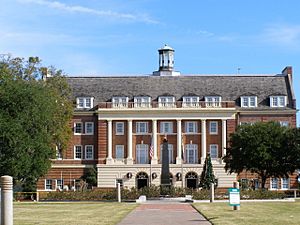
Florida A&M University (FAMU) was founded in 1887. It is a public, historically black university. FAMU's main campus has 156 buildings on 422 acres. It is on the highest hill in Tallahassee.
FAMU offers many bachelor's and master's degrees. It also has 11 doctoral programs, including engineering and physics. Some of its top programs are architecture, journalism, and pharmacy.
Tallahassee State College
Tallahassee State College (TSC) is part of the Florida College System. It was founded in 1966. Its main campus is on 270 acres in Tallahassee.
TSC offers different types of degrees. In 2013, it was ranked first in the nation for students graduating with A.A. degrees. TSC is also the top school for students transferring to Florida State University and Florida A&M University. In 2024, Tallahassee Community College changed its name to Tallahassee State College.
Economy and Jobs
Tallahassee is home to several companies. These include Citizens Property Insurance Corporation and the Municipal Code Corporation.
Top Employers in Tallahassee
| # | Employer | # of Employees (2021) |
|---|---|---|
| 1 | State of Florida | 26,042 |
| 2 | Florida State University | 15,011 |
| 3 | Tallahassee Memorial Hospital | 5,349 |
| 4 | Leon County School Board | 4,300 |
| 5 | City of Tallahassee | 2,856 |
| 6 | Walmart | 2,655 |
| 7 | Publix | 2,543 |
| 8 | Florida A&M University | 1,749 |
| 9 | Leon County | 1,744 |
| 10 | Tallahassee State College | 1,475 |
| 11 | Capital Regional Medical Center | 1,095 |
Arts and Culture
Tallahassee has many places for fun and art. These include theaters, museums, and parks. The Railroad Square Art Park is a popular spot.
Museums to Visit
Tallahassee is known for its many museums. You can visit the Museum of Fine Arts at FSU. Other museums include the Tallahassee Museum, Goodwood Museum & Gardens, and the Museum of Florida History. The Mission San Luis de Apalachee and the Tallahassee Automobile Museum are also popular.
Music Scene
Many famous musicians have ties to Tallahassee. Ray Charles visited family here and performed in Frenchtown. George Clinton of Parliament-Funkadelic has lived in Tallahassee since 1994.
T-Pain, a well-known musician, was born and raised in Tallahassee. The Emo band Mayday Parade started here. The Post-grunge band Creed also formed in Tallahassee in 1994.
Festivals and Events
Tallahassee hosts many fun festivals and events throughout the year.
- Downtown Getdown (a pep rally for Florida State Seminoles)
- First Friday festivals at Railroad Square
- Greek Food Festival
- Springtime Tallahassee
- Tallahassee Wine and Food Festival
- Winter Festival
Sports in Tallahassee
Tallahassee is a big sports town, especially for college athletics.
Florida State Seminoles Teams
The Florida State Seminoles are the sports teams of Florida State University. They are very popular and bring in a lot of money for college sports.
| Teams | Division | Conference | Venue | Capacity |
|---|---|---|---|---|
| Florida State Seminoles football | D-1 (FBS) | ACC | Doak Campbell Stadium | 79,560 |
| Florida State Seminoles men's basketball | D-I | ACC | Donald L. Tucker Center | 12,500 |
| Florida State Seminoles women's basketball | D-I | ACC | Donald L. Tucker Center | 12,500 |
| Florida State Seminoles baseball | D-I | ACC | Dick Howser Stadium | 6,700 |
| Florida State Seminoles softball | D-I | ACC | JoAnne Graf Field | 1,000 |
| Florida State Seminoles women's soccer | D-1 | ACC | Seminole Soccer Complex | 2,000 |
| Florida A&M Rattlers | D-1 | SWAC | Bragg Memorial Stadium | 25,500 |
| Florida A&M Rattlers men's basketball | D-I | SWAC | Teaching Arena | 8,470 |
Transportation
Getting Around by Air
- Tallahassee International Airport (KTLH) is the main airport for the city.
Bus Services
- StarMetro provides bus service all over Tallahassee.
Major Roads
 Interstate 10 goes across the north side of the city.
Interstate 10 goes across the north side of the city. U.S. Route 27 runs through downtown Tallahassee.
U.S. Route 27 runs through downtown Tallahassee. U.S. Route 90 goes east–west through the city.
U.S. Route 90 goes east–west through the city. U.S. Route 319 runs north–south on the east side of the city.
U.S. Route 319 runs north–south on the east side of the city.
Places of Interest
- Alfred B. Maclay Gardens State Park
- Challenger Learning Center
- Doak Campbell Stadium
- Elinor Klapp-Phipps Park
- Florida Governor's Mansion
- Florida State Capitol
- Florida Supreme Court
- Goodwood Museum and Gardens
- Knott House Museum
- Lake Ella
- Lake Jackson Mounds Archaeological State Park
- Mission San Luis de Apalachee
- Museum of Florida History
- National High Magnetic Field Laboratory
- Railroad Square
- Tallahassee Automobile Museum
- Tallahassee Museum
- James D. Westcott Building at Florida State University
Sister Cities
Tallahassee has five sister cities around the world:
 Konongo-Odumase, Ghana
Konongo-Odumase, Ghana St. Maarten, Netherlands Antilles
St. Maarten, Netherlands Antilles Sligo, Ireland
Sligo, Ireland Rugao, China
Rugao, China Ramat HaSharon, Israel
Ramat HaSharon, Israel
Images for kids
-
Union Bank, Florida's oldest surviving bank building
See also
 In Spanish: Tallahassee para niños
In Spanish: Tallahassee para niños



